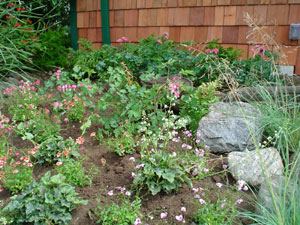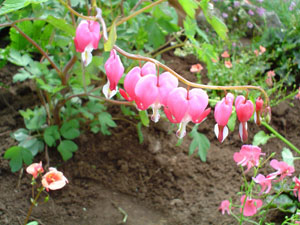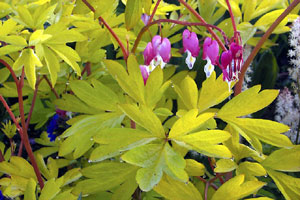 By MAUREEN GILMER DIY Network July 11, 2005
Those are the Victorian sentiments of John Ruskin as he spoke of the gentle beauty of delicate flowers. They lie sequestered in shady dells and forest glades. They are ephemeral, blooming for a time in spring before the onset of summer heat. Their foliage is fern-like, wispy and fragile. With the dog days of summer they may die back entirely to wait out the dry season before winter.
Delicates hide amidst the ferns. They are found in little used corners under trees. Such gems are surprises in the garden. They persist year after year to create more fairy blooms each season. The sentiments of the Victorian era and Ruskin in particular are embodied in a single plant, the bleeding heart. This beautiful perennial is so named because its pendulous flowers do indeed resemble exquisite rosy hearts. The pendulous blooms are borne on delicate airy stems held well above the flowers. Even the slightest breeze starts them swaying to add a delightful animation to otherwise static plantings. The bleeding heart of gardens is "Dicentra spectabilis," but there are others closely related that are native to our soil. These wild bleeding hearts that can be found across America. They prefer to grow where there is even moisture with many dying back at midsummer. Among them is "Dicentra cucullaria," known as Dutchman's breeches and found throughout most of the eastern states. Rather than heart-shaped blossoms they feature pantaloons. The more commonly grown wild species includes "Dicentra eximia" from the middle Atlantic states. On the opposite coast grows the western bleeding heart, "Dicentra formosa." The species is found in forests of the Pacific Coast states from Canada south into California. In its southern, drier range it can be found sprouting out of cliff bases above river canyons were it thrives off water running deep in fissures of the rock. Plants may all but disappear as this seasonal runoff dries up in the summer. European breeders have crossed our two native species to produce excellent garden varieties for light shade. 'Luxuriant' is among the most famous and widely grown. Super cold hardy, it survives to Zone 3. It was one of the first plants ever patented. It can be relied on to bloom from mid-spring to mid-summer if you keep them adequately moist and pick spent flowers promptly after they fade. Other cultivars from this line include a half dozen white varieties to add diversity to these plantings. 'Coldham' features burgundy blossoms. A ruby red version is named 'Adrian Bloom' and a highly floriferous purple pink is called 'Bountiful.' Plant these in the shade under tree canopies where they thrive in the acidic soils with plenty of organic matter and good drainage. The Asian bleeding heart has been in gardens longer than the American hybrids. In fact, it is an old Victorian favorite that still grows in old gardens. It is found thriving under large tree canopies or on north facing exposures with moisture and a lot of light. This species is from Korea, northern China and Siberia, proving its extreme cold hardiness. This makes it an excellent choice for northern gardens. "Dicentra specitabilis" produces the more rounded heart-shaped flowers with the little white "blood drop." To many this is preferable to the oblong American native wildflowers and their hybrids such as 'Luxuriant.' Among these Asian hybrids, 'Gold Heart' offers lime green foliage that makes the lighter pink flowers more readily visible than the standard green foliage. Don't waste your bleeding hearts in beds and borders far from outdoor living spaces. Plant these fairy flowers up close and personal ... around patios, decks and in foundation plantings. Let them carpet the ground under dogwoods, Japanese maples and saucer magnolia for an extraordinary spring show. And don't forget to press the blossoms in books to add kind hearts and flowers to your most beloved correspondence all year around.
|
||


